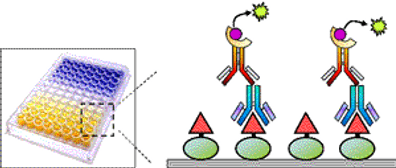Immunoassay and Biosensor
Immunoassays use antibodies to bind to the analyte of interest and a variety of labels are used to detect this binding (e.g. colorimetric, fluorescent, chemiluminescent, radioisotopes). The most common form is the enzyme linked immunosorbent assay. Although these assays use a ‘biological’ reagent – the antibody – the assays are not bioassays, but rather an analytical method that is governed by the Law of Mass Action. An advantage of immunoassay, is that it is rapid and cost effective, particularly when there are large numbers of samples to run. The assays are adaptable to many forms including tube assays, 96-well microtiter plates, or high throughput analyzers as well as more complex microarrays or biosensors.

The focus of the research is to develop tools to monitor human and environmental exposure to environmental contaminants. Such contaminants include pesticides, industrial chemicals or their byproducts, and personal care products. Because we are interested in both human and environmental monitoring, we typically develop a library of assays to cover the parent compound, environmental breakdown products and mammalian (human) metabolites. With human monitoring we are particularly interested in metabolites that are excreted in the urine, as urine sampling is quite easy. These metabolites could then be used as biomarkers of exposure. In the event that information about metabolism is unclear we can use accelerator mass spectrometry as a highly sensitive method to detect metabolites in urine and blood. Once the metabolites are identified, assays can then be selectively developed. Since monitoring studies result in large numbers of samples to be analyzed improving throughput is important. Toward this goal, we have adapted assays to clinical analyzers and have made progress in multiplexing assays on multifunctional nanoparticles. The nanoparticles are utilized in a flow through microchannel device that can be designed for portability.
Skills and Accomplishments
-
More than 40 immunoassays developed for pesticides, pesticide metabolites and environmental degradation products, and other environmental contaminants.
-
Expertise in hapten design for optimal antibody selectivity
-
Single analyte detection
-
Class selective detection
-
Expertise in cleanup and concentration methods designed for particular needs of immunoassay
-
Have successfully transferred technology to government agencies, academic and commercial research laboratories domestically and internationally.
-
Specific Research Examples
-
Used immunoassays to measure pesticides in urine, blood, saliva, foods, soil, sediment, water, and air
-
Used an immunoassay to measure exposure to the herbicide paraquat in Costa Rican farmworkers as part of study on effects of paraquat on lung function.
-
Used accelerator mass spectrometry to identify human metabolites of atrazine at low exposure doses and confirm atrazine mercapturate as a biomarker of exposure to atrazine.
-
Validated assays for pesticide biomarkers, atrazine mercapturate (for the herbicide atrazine) and 3-phenoxybenzoic acid (for pyrethroid insecticides)
-
Developed and validated assays for the environmental contaminant, 2,3,7,8-tetrachlorodibenzo-p-dioxin (TCDD), in soil and sediment
-
Developed a novel assay for mercury
-
Explored mathematical approaches to address cross reactivity among compounds that are structurally similar to the analyte
-
-
For a list of assays and to inquire about availability click here.

Current Research Projects
-
Use of existing immunoassays in exposure studies (PBDEs in house dust and serum)
-
Development of assays for insecticides fipronil and imidacloprid.
-
Development of assays for personal care products, triclocarban and triclosan
-
Development of assays for toxic compounds such as acrylamide
-
Development of assays for urinary metabolites as biomarkers of exposure (acrylamide, triclocarban, triclosan, fipronil, imidacloprid)
-
Development of phage displayed peptides as immunoassay reagents
-
Use of multi-functional nanoparticles that are magnetic and luminescent to develop particle-based immunoassays with internal standardization for protein toxins such as ricin and Botulinum toxin
-
Miniaturization of assays for application in microfluidic channels toward development of biosensor
